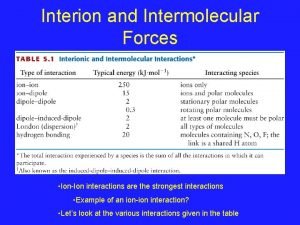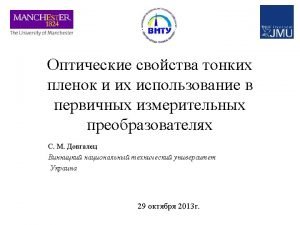Size dependence of dipole and quadrupole plasmon resonances

- Slides: 1

Size dependence of dipole and quadrupole plasmon resonances of light-induced sodium clusters Anastasiya Derkachova, Krystyna Kolwas Institute of Physics, Polish Academy of Sciences, Al. Lotników 32/46, 02 -668 Warsaw, Poland Abstract Mirror Polarizer 1 Induced beam source Scattered intensities : a) experimental; b) Mie theory a) 12 Probe Beam source Cell Polarizer 2 Shatter SSD spectrometer IV (I ) Polarization of detected light IH (III) This work was partially supported by the Polish State Committee for Scientific Research (KBN), grant No. 2 PO 3 B 102 22. 6 4 IV 2 IH 0 2 4 6 8 10 12 14 Time [s] Polarization geometry Polarization of incident light 8 0 Half-transmitting mirror Computer 457. 9 514. 5 568. 2 647. 1 10 Intensities [a. u. ] We study the dependence of the optical properties of large sodium clusters as a function of their size. Sodium clusters are light induced [1, 2] giving the unique opportunity of observing the smooth change of their sizes as a result of the spontaneous nucleation process in supersaturated vapor. Supersaturation is due to dissociation of Na 2 molecules initiated by switching-on of the laser light at frequency resonant with some transition frequencies in sodium Na 2 molecules. We measure the scattered intensities of the probe laser beam with polarization parallel and perpendicular the observation plane. The measurement is performed for several wavelengths of the probe light scattered by clusters growing with time. The full Mie scattering theory is used to describe intensities of light scattered by growing clusters in directions orthogonal to the direction of the incident light beam. The Drude dielectric function of free-electron metal is used to describe the optical properties of studied clusters. The method of finding the dependence of cluster radius and relative concentration is presented. We combine the formalism of the classical Mie scattering theory for arbitrary large size and the concept of the collective electron oscillations (plasmons) [3, 4]. The maxima in normalized intensities of light scattered by single cluster we attribute to resonant excitation of dipole and quadrupole plasmon oscillation respectively. We show that plasmon resonances take place for different cluster sizes when excited with different wavelength. We compare these results with expectations resulting from solving the problem of eigenfrequencies of freeelectron sphere with the dielectric function described within Lorentz-Drude model. Experimental setup b) Mechanism of sodium clusters condensation Resonance excitation of dimers References: 1. K. Kolwas, M. Kolwas, D. Jakubczyk, Appl. Phys. B 60, 173 (1995), 2. Demianiuk S, Kolwas K. J. Phys. B, 34, 1651 (2001), 3. K. Kolwas, S. Demianiuk, M. Kolwas, J. Phys. B, 29, 4761 (1996), 4. K. Kolwas, S. Demianiuk, M. Kolwas, J. Chem. Phys. , 106(20), 8436 (1997) Na 2 488 nm Na 2* Collision assisted dimers dissociation collisions Na 2* Na+Na * Sodium vapour supersaturation Clusters condensation Looking for the best radius Evolution of cluster radius and concentration Identification of plasmons in scattered light R(t) [nm] 160 120 80 40 0 0 2 4 6 8 10 12 14 Concentration [a. u. ] Time [s] 7 10 5 10 3 10 1 10 a) Plasmon resonances: a) experimental; b) Mie theory 0 2 4 6 8 Time [s] Plasmon resonance frequencies Summury · The spontaneous nucleation process of clusters experimental Mie theory with Drude dielectric function induced by light [1, 2] gives the unique opportunity of observing the smooth change of cluster size up to the macroscopic droplet of radius of about 150 nm. That enables the study of optical properties of freeelectron clusters as a function of sizes in wide range up to hundreds of nanometers. · The presented experimental results seams to be the b) first observation of manifestation of: • the dipole plasmon resonance in clusters of so large sizes as few tens of nanometers, • the quadrupole plasmon resonance · The presented experimental results are not contradictory with theoretical predictions of the problem of eigenfrequencies of free-electron sphere with the dielectric function described within Lorentz -Drude model

